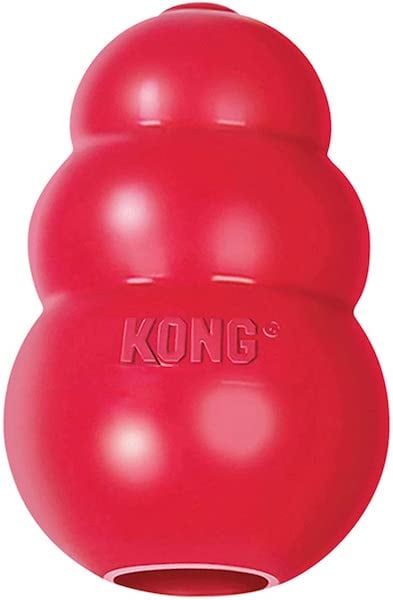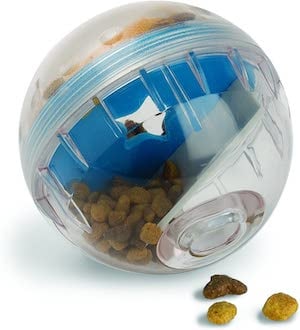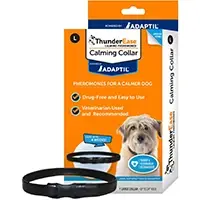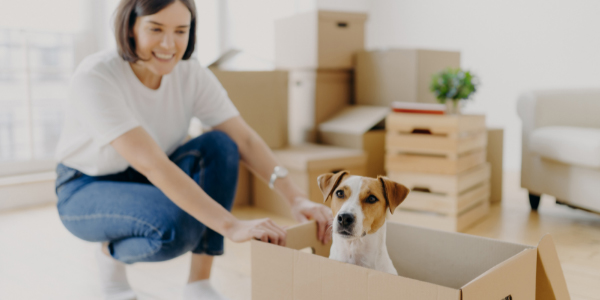 Moving is one of my least favorite things.
Moving is one of my least favorite things.
Yes, there’s the excitement of setting up a new home and exploring the neighborhood, but it’s the little things that I wish would just take care of themselves — the packing, the heavy boxes, the boxes that were never unpacked from the last move (should I just throw it away already?), the unpacking, the utility transfers, and account cancellations … it can be really stressful!
I recently moved into a new home and thought a lot about how to make the move as stress-free as possible for my dog Sookie. Moving when you have a dog adds another layer of preparation and management, but with some planning and extra care, your dog can acclimate quickly to their new home.
Sookie has moved with me a few times before, but this was the first time that she would be moving without her older “dog brother” Mikey, who had always been the easy-going one during moves and had helped her feel calmer with all the changes. Not to mention that Mikey’s ability to acclimate easily to new places helped my own anxiety and stress.
I was worried that this move would be stressful for my dog, not only because Mikey was no longer with us, but also because we were combining two households and the daily routines would be different than what my single life had been like.
No more sleeping in and morning cuddles — there would now be a 7-year-old child in the mix (who, luckily, she already adored), meaning early morning wake-up routines with the mad dash to get him off to school.
Our relaxing walks in the more suburban neighborhood we lived in would be replaced with the city life, with all its loud noises, traffic, and often overwhelming busyness.
There are things you can do to set your dog up for success before, during, and after the big move. By planning ahead and following the steps laid out for you below, I’m happy to report that Sookie has settled in quite well to our new home.
While I still have quite a few boxes left packed (shoved unceremoniously into the garage corner where most likely they will remain until the next move), seeing her relaxed and acclimated has made the move less stressful for me as well.
Get Your Dog Ready Before You Move
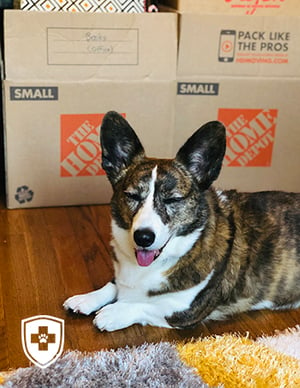
Get Your Dog Used to Moving Supplies
In the few weeks before you move, start to desensitize your dog to the sight of moving boxes and other moving supplies (like the sound of packing tape).
Have you noticed that dogs key in very quickly to things that predict a change in routine? Pull out a suitcase, and many dogs know you’re leaving on a tri,p and this can trigger anxious behavior, especially if your dog already suffers from separation anxiety.
Collect some moving boxes and simply place them against a wall or in a corner. Don't make a big fuss over them and let your dog explore them at their own pace.
If your dog is especially worried about these new things, you can create a positive association by tossing a yummy treat their way if they approach the boxes on their own.
As your dog gets used to the presence of the boxes, you can start opening them up and moving them around the home. Your goal here is to make these moving supplies a positive, or at least a neutral thing in your dog's mind. Plus, it prevents a mad dash to find, build, and pack boxes the day before or the day of your move. A win-win for dogs and humans alike!
Keep Your Dog's Regular Routine (As Much As Possible)
As moving day gets closer, try to keep your dog's routine as regular as you can. Stick with their regular walking and feeding times. Take them out for their usual potty breaks or evening playtime in the yard. Consistency helps your dog relax and feel safe, since they know what to expect. If too much changes occur too quickly, they can get anxious due to the lack of structure in their day.
Learn more about how a daily structure benefits your dog, especially during life events like moving, in our "Do Dogs Need a Daily Routine?" article.
Take Your Dog for Walks in Your New Neighborhood
Obviously, if you're moving far away from your current home, this step isn't possible. But if you're moving somewhere that's easy for you to get to on a regular basis, such as across town or even just down the road, it's helpful to introduce your dog to that neighborhood ahead of time.
Take your dog for regular jaunts around what will be their new neighborhood, allowing them to explore and take in all the sights, sounds, and smells. This will help them feel more acclimated and comfortable when their regular walks happen in this environment since they've had a chance to read all the "pee-mail" (and leave their own) in the area already.
- Update your dog's microchip with your new address and make sure your contact info is current.
- Check with your veterinarian about any vaccinations or additional parasite preventatives your dog might need in your new area.
- Make an introductory appointment with a veterinarian in your new neighborhood.
Provide Lots of Physical Exercise
Even though your schedule can get a little jam-packed as moving day gets closer, make sure that your dog is still getting enough physical exercise. While their regular walks are important, off-leash time in a safely enclosed area to play fetch or play with their doggie pals is helpful in keeping your dog in great shape and less stressed.
Swimming is another great option for burning off excess energy (as long as your dog knows how to swim!), as well as playing with a flirt pole. Exercise is a great stress-reliever for you and your dog!
Keep Your Dog's Brain Entertained
Mental exercise and enrichment are another important stress reducer for your pup and help them practice appropriate behaviors instead of deciding to rip up your couch cushions because they're anxious or bored.
Provide your dog with their favorite food and treat puzzles or interactive toys while you pack up more boxes, like a stuffed Kong, West Paw Toppl toy (my personal favorite stuffable toy), or IQ Treat Ball.
Not only does working for their food tire out your dog's brain, but it's also an easy way to reduce stress by keeping them busy and focusing their attention on a positive activity. You can even make your own puzzles with things from around your home, like this DIY Food Tube Puzzle that I made for Sookie:
Mental enrichment can also include other activities that aren't food-centric. If your dog loves to dig, find somewhere they can dig to their heart's content, such as a beach or lake. Go on a "sniffari," where your dog can choose where they want to go on the leash (as long as it's safe) and can stop and "smell the roses" for however long they'd like.
All of that information they are smelling is extremely enriching and stimulating for their brain, not to mention that you'll be able to take a deep breath and relax outdoors as well. Moving is stressful, and taking the time to connect with your dog throughout the process will keep you sane and your dog calm and confident.
Give Your Dog a Safe Space
A safe space (or long-term confinement area if you have a puppy or young dog) is essential to help your dog feel calmer when everything is in flux around them. Having a safe space set up where you're moving from, and then setting up a similar safe space with those same items in the home you're moving to, also gives your dog something familiar and comforting that's consistent between the two places.
Safe spaces include a quiet and secluded resting area, water, comforting toys or owner clothing, and calming dog pheromones (using a couple spritzes of spray-on pheromones or a plug-in pheromone diffuser).
For a list of what you'll need and how-to's, click here to read "How to Set Up a Safe Space for Your Dog." (For young puppies or dogs that are still working on house training or not chewing up things when left alone, you'll want to set up a "Puppy Zone: How to Set Up a Long Term Confinement Area.")
To help ease any anxiety throughout the move, you can also put an ThunderEase pheromone collar on them a few days prior to the move and start them on calming supplements, like Solloquin or Composure treats.
If a road trip is part of your move, it's important to ease any travel anxiety or car sicknesses to make the trip easier for everyone. Read more tips about Preventing and Treating Travel Anxiety and Preventing and Treating Car Sickness.
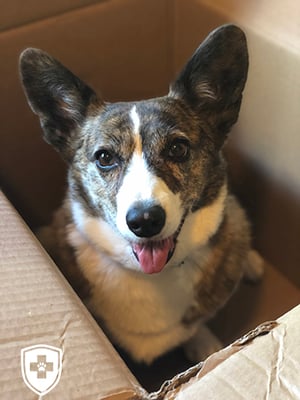 Ways to Help Your Dog on Moving Day
Ways to Help Your Dog on Moving Day
Find a Trusted Dog Sitter for Moving Day
You're going to be busy enough on the actual day of the move that the last thing you need is a dog underfoot. Plus, all the hubbub on moving day can be extremely stressful on dogs. The open doors are a safety hazard as well, providing ample opportunity to door dash and have an adventure out in the neighborhood.
Save yourself and your dog the hassle and plan for them to stay with a trusted friend, dog daycare, or pet sitter while you get everything loaded and unloaded.
If you're moving to a new area and don't know anyone who can watch your dog, block off a room with a baby gate for them to hang out in, where they can relax with a chew and avoid all the hustle and bustle of moving things in.
Take a Long Walk to Your New Home
When you arrive at your new home, give your dog a long walk that ends at the new place. Not only does this burn some physical energy but it also creates a nice journey together for you that ends at your new home. Allow your dog to take in all the new smells of the neighborhood during this walk to familiarize themselves with their new outdoor environment.
Positive Exploration of the New Place
When you first enter your new home with your dog, take some time for them to explore at their own pace. I like to keep my dog on leash and go through the new place room by room, offering her a treat in every room. If your dog shows any hesitation at exploring any certain area, don't force it and give them time to get acclimated.
Having them on a leash will set your dog up for success, giving you a way to keep them out of areas that they aren't allowed in and providing a nice connection that can help them feel more confident as they explore their new home with you.
Make sure to keep your voice and energy calm and happy, praising them for any good behavior in your new home.
PRO TIP: Before your dog's first "walk-thru" of the new home, make sure everything is dog-proof. Here's a 10 Point Checklist for Dog Proofing Your New Home.
Set Up Your Dog's New Safe Space
Hopefully, you've had a chance to set up your dog's safe space in the new place before bringing them home, but if not, set it up with them and make sure they know where it is in case they want to hunker down for a bit. You can feed them in their safe space to build a positive association with the new space and encourage relaxation by plugging in a calming pheromone diffuser nearby.
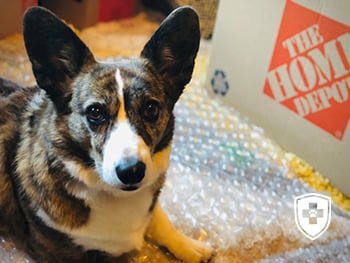
After You Move: Your Dog's Transition Period
Once you're all moved in and unpacked, you can help your dog settle in more quickly by getting back to their normal routine as quickly as possible. Making sure they get enough exercise is also important. A tired dog is less likely to engage in anxious behaviors or boredom behaviors, like destructive chewing.
Exploratory walks around the neighborhood provide an opportunity to get both physical and mental exercise, as well as giving you (and your dog) the chance to meet your new neighbors.
Help Your Dog with Any Transition Anxiety
It's normal for many dogs to exhibit symptoms of anxiety after moving. Be patient with your dog if they're a bit anxious about all the change.
My dog Sookie has regressed in her separation anxiety since our move, so I have been careful to not leave her alone in the new place for very long and went back to the first few steps of absence desensitization to teach her that being alone is actually pretty great (that's when the stuffed Kong comes out of the freezer!). I've also made sure to leave some calming music on for her when I do leave to help ease any anxiety and to mask any noise outside that might make her bark.
To learn how to teach your dog that alone time is actually pretty great, read more in "Home Alone: Why It's Important to Teach Your Dog to be Alone."
I've also made sure to give her lots of love and reassurance when she asks for it. Don't be afraid to comfort your dog when they're showing uncertainty. They're looking to you for cues on whether to be worried or not, so there's nothing wrong with giving them some cuddles, praise, and petting when they seek it out.
The biggest thing to remember is to comfort, not coddle. If you're acting nervous or anxious as you reassure your pup, they will key into that and possibly mirror that anxiety.
It's been a little more than a month since our move, and Sookie is no longer shadowing me from room to room and is able to settle in her safe space with her toys and favorite chews while I continue to unpack the never-ending boxes.
Moving with a dog doesn't have to be stressful! Just taking a little time to plan ahead and make sure your pup knows you're there for them will go a long way.
Have questions about your upcoming move with your dog? Any tips that have worked well for you and your pup when you've moved? We'd love to hear them — share them in the comments below!



